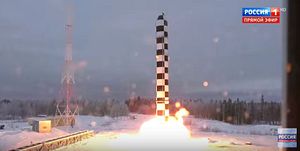On June 2, the Russian government published a single document outlining its national perspective on nuclear deterrence. The short, six-page document — formally titled “Basic Principles of State Policy of the Russian Federation on Nuclear Deterrence” — was authorized for publication on June 2 in an executive order signed by Russian President Vladimir Putin. An official English translation was made available by the Russian Ministry of Foreign Affairs on Monday, June 8.
The document serves to largely reinforce conventional understandings of Russian nuclear policy, with no shocking new statements on the role of nuclear weapons in the country’s national defense strategy. While the document is unprecedented as a public release, previous analogs that likely existed in the Russian system were kept classified. Previous public statements on the role of nuclear weapons in Russia’s strategy appeared in the country’s military doctrine, but not with the same level of detail.
The timing of the document’s publication is notable. June 2, 2020, is barely seven months before the slated expiration of the 2010 U.S.-Russia Strategic Arms Reduction Treaty. The United States continues to hold out on this treaty’s extension, despite Russian offers for an unconditional agreement to move ahead with the Treaty’s provision for a single five-year extension. There’s little common understanding between the two sides; the 2019 end of the 1987 Intermediate-Range Nuclear Forces Treaty, spurred by Russia’s violation, also doesn’t help matters.
Washington, meanwhile, has alleged that Russian nuclear policy has dangerous designs that include possible plans to introduce nuclear weapons into an otherwise conventional conflict to seek deescalation on terms favorable to Moscow (an “escalate-to-deescalate” strategy, as some prefer to call it). The Trump administration’s 2018 Nuclear Posture Review made this case directly. For instance, the following passage appears in the 2018 NPR on Russia’s nuclear strategy:
Russian strategy and doctrine emphasize the potential coercive and military uses of nuclear weapons. It mistakenly assesses that the threat of nuclear escalation or actual first use of nuclear weapons would serve to “de-escalate” a conflict on terms favorable to Russia. These mistaken perceptions increase the prospect for dangerous miscalculation and escalation.
Little in the new Russian basic principles directly supports this reading of Russian nuclear strategy. Rather, like previous understandings on the subject from publicly available Russian documents, the new basic principles suggest that Russia intends to practice deterrence toward existential threats with nuclear weapons. The credible threat of nuclear retaliation is meant to deter threats to the existence of the Russian state:
The Russian Federation reserves the right to use nuclear weapons in response to the use of nuclear and other types of weapons of mass destruction against it and/or its allies, as well as in the event of aggression against the Russian Federation with the use of conventional weapons when the very existence of the state is in jeopardy.
Elsewhere, there’s some slightly more tendentious language that could be interpreted by American proponents of the existence of a Russian “escalate-to-deescalate” strategy as evidence of their thesis. For instance, a much earlier paragraph in the document says that “this Policy provides for the prevention of an escalation of military actions and their termination on conditions that are acceptable for the Russian Federation and/or its allies.” (emphasis added)
Olga Oliker, an expert on Russian nuclear policy, offers one answer to resolve this apparent discrepancy. Where the latter statement pertains to deterrence (and deterrent threats that may be made in the lead-up to or in the course of a conflict), the former explains the conditions for nuclear use directly. Once the existential conditions for nuclear use are met, “and Russia decides to use nuclear weapons, Russia will do so intending to prevent further escalation and end the conflict as favorably (or acceptably) as possible for itself,” Oliker explains.
It’s probably not going to be the case that this new Russian document will end American debates on Russian intentions for once and for all. What will be interesting, however, is how American policymakers will view the utility of this publication going forward. For instance, there’s the question of how — and whether — the 2018 NPR might have cited or viewed a similar document had it existed before 2018 (the Russian military doctrine’s nuclear component was not directly cited). Similarly, if the Trump administration is to be succeeded by a Biden administration in 2021, how might the authors of a possible 2021 or 2022 American NPR view this document?

































